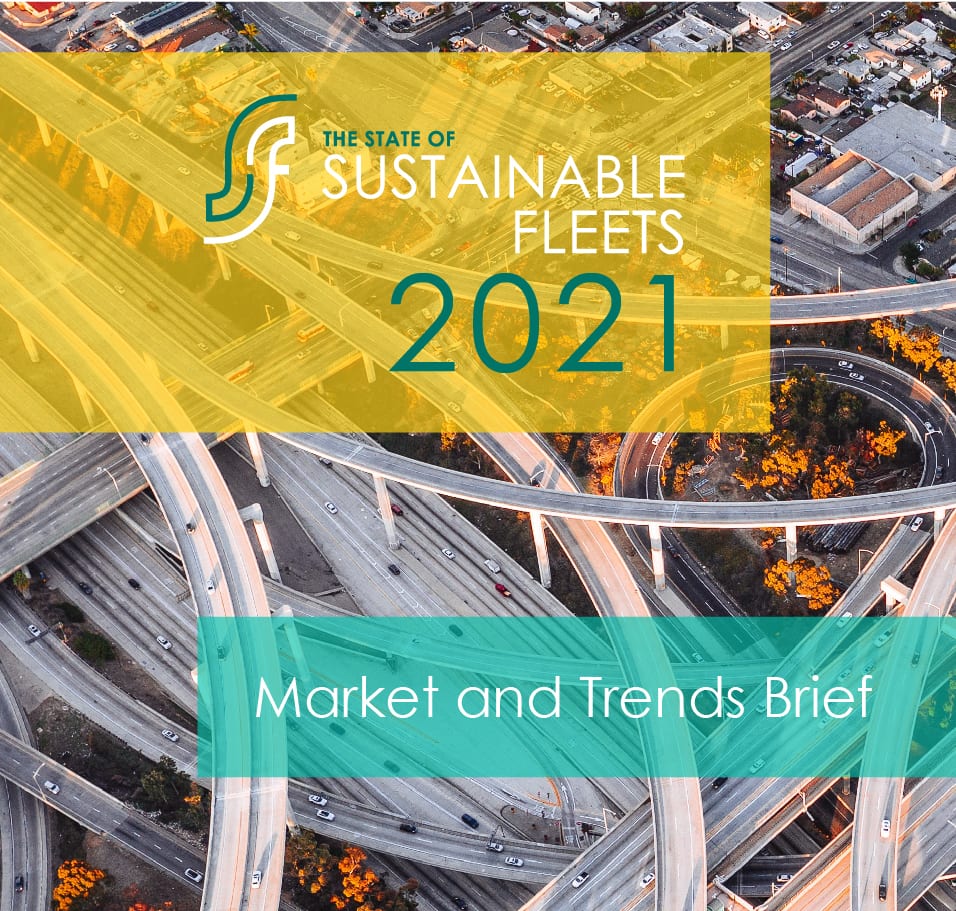In an update to last year’s inaugural State of Sustainable Fleets Report, GNA’s 2021 Market and Trends Brief shows that even with the ongoing effects felt from the COVID-19 pandemic, the clean tech industry made progressive steps, leading to greater adoption by fleets across the country.
This year’s supplement to the 2020 report examines the current state of leading on-road clean vehicle technologies for fleet operators. Sourced from more than 400 survey results from medium- and heavy-duty fleet operators across the U.S., the assessment’s findings also include industry data and independent technical analysis. New this year, short educational “Miniguides” were produced on each of the four leading clean vehicle drivetrain technologies covered in the 2021 Market and Trends Brief: Propane Vehicles, Natural Gas Vehicles, Battery-Electric Vehicles, and Fuel Cell Electric Vehicles.
GNA’s 2021 Market and Trends Brief updates last year’s inaugural State of Sustainable Fleets Report.
“This year’s analysis and extensive fleet survey reinforces what we have been witnessing across the industry,” said Erik Neandross, CEO of GNA, the firm authoring the report. “With the total cost of ownership increasingly being confirmed across multiple clean fuel and technology options, fleets continue to expand their commitment to and investment in these sustainable vehicle options, a trend we fully expect to continue to accelerate in the coming few years.”
Produced with support from the report’s title sponsors Daimler Trucks North America, Penske Transportation Solutions, and Shell Oil Company, and supporting sponsors Cummins, Inc., DTE Energy, and Geotab, the report offers additional insights into the key trends shaping the clean vehicle market. The assessment focuses on the leading sustainable fuel and vehicle technologies being adopted in the medium- and heavy-duty fleet sectors: gasoline/diesel fleet and engine efficiency, natural gas vehicles, propane vehicles, battery-electric vehicles, hydrogen fuel cell electric vehicles, and renewable fuels for each of the technology options. The analysis covers public, private, and for-hire fleets, including school, municipal, shuttle, urban delivery, refuse, public utility, transit, regional-haul, and long-haul sectors.
The report focuses on the leading sustainable fuel and vehicle technolgies being adopted across fleet sectors.
Fleets reported significant business benefits when clean vehicle technologies are mature and appropriately suited to their sector, including fuel cost savings, improved total cost of ownership, and reduced maintenance. The improved environmental performance of these technologies also remained a benefit consistently confirmed by surveyed fleets. The year’s assessment concludes that leading fleet operators are utilizing a mixture of clean technologies along with incumbent fuels and efficiency measures, enabling them to realize immediate emission reductions while satisfying their own increased commitments on sustainability, and demands from customers for the same. This diversified technology landscape has created a multi-fuel near-term reality for many of today’s fleets. In support of this, the report put forward five key findings:
- Fleets report superior total cost of ownership and fuel costs savings when operating on the mature technologies of compressed natural gas in the refuse, transit, and dedicated heavy-duty sectors and on propane in the school, paratransit, and urban delivery sectors.
- Battery-electric vehicles are poised to become a leading clean fleet technology in three to five years. Commitments by several large fleets will require vehicle deployments in the tens of thousands per year. While vehicle costs remain high for this developing technology, and OEMs are just beginning to enter serial production, investment to build this market is already enormous and growing.
- Fuel producers and vehicle makers continued investing hundreds of millions globally adding to the billions of dollars already committed to build a foundation for fuel cells, doubling the number of models coming to market, mostly for transit and Class 8 tractors.
- Two powerful drivers — policy mandates and ambitious sustainability goals — are creating demand for all clean technologies and will continue to drive growth.
- Sustainability benefits, including the emissions reduction potential of vehicles and fuel, are improving for nearly all existing clean vehicle technologies, including efficiency, renewable fuels, and cleaner vehicles. Sustainability benefits remain a top motivator for fleets.
Unique to findings this year, the assessment includes insights from non-adopter fleets — those that have never used one of the four leading clean vehicle drivetrains included in the assessment. Data and insights from these non-adopter fleets help better evaluate their readiness and perceived, or actual, barriers to technology adoption. Notably, these fleets report they would need to be convinced of total cost of ownership benefits, proven performance of clean vehicles by similar fleets, and improved fueling availability — much of which is reported in this analysis — before implementing clean vehicles.
For more information about the report, visit www.StateofSustainableFleets.com.


